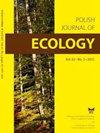海拔高度和叶龄对高山灌木叶片形状的影响:叶面积估计模型的相关性
IF 0.7
4区 环境科学与生态学
Q4 ECOLOGY
引用次数: 0
摘要
通过叶长(L)和/或叶宽(W)估计叶面积(LA)的无损方法在植物生理学和生态学研究中很有用。然而,环境和个体发生因素都可能影响叶片大小和/或形状,这可能会改变LA模型的系数。我们沿着西藏东南部的色热姆拉山脉的海拔梯度进行了调查。2009年8月,我们在海拔4250米至4640米的大约每50米的地方选择了9个地点。共测量了4245片不同叶龄的杜鹃花(一种优势种)叶片。与一维模型相比,包含L和W的二维模型(模型5)在每个地点的不同叶龄组中反映出更高的R2(0.98–0.99)和更低的MSE(1.19–3.21),这意味着该模型可以为LA估计提供最佳拟合。协方差分析进一步表明,在九个地点中的八个地点,双叶维度模型与叶龄效应无关。叶片形状(L:W比)在不同地点之间变化,并在较高海拔(4500–4640 m a.s.L.)趋于减小,导致每两个相邻地点之间的二维模型系数存在显著差异。对于高山栖息地的过度繁殖物种,海拔而不是叶龄可能会影响叶片形状,从而改变LA估计模型的系数。由于不同物种(上层物种与下层物种)的叶片形状可能对特定的环境梯度表现出不同的反应,研究人员在通过测量L和W来估计物种特异性LA时必须注意叶片形状的变化,特别是当在不同地点收集上层物种的叶片时。本文章由计算机程序翻译,如有差异,请以英文原文为准。
Effects of Altitude and Leaf Age on Leaf Shape in an Alpine Shrub: The Relevance for the Leaf Area Estimation Model
ABSTRACT Nondestructive methods to estimate leaf area (LA) by leaf length (L) and/or width (W) are useful in plant physiology and ecology studies. However, both environmental and ontogenic factors may influence leaf size and/or shape, which may alter the coefficient of LA models. We carried an investigation along an altitudinal gradient in the Sergyemla Mountains, southeast Tibet. In August 2009, we selected nine sites at about every 50 m in altitude from 4,250 m to 4,640 m a.s.l. A total of 4,245 different leaf-aged Rhododendron aganniphum var. schizopeplum (a dominant overstory species) leaves were measured. Compared with the single dimensional models, the two-dimensional model encompassing both L and W (model 5) reflected higher R2 (0.98–0.99) and lower MSE (1.19–3.21) across different leaf age groups for each site, implying that such model could provide the best fit for LA estimation. Analysis of covariance further illustrated that two leaf dimensions model was irrespective of leaf age effects in eight out of the nine sites. Leaf shape (L:W ratio) varied between sites and tended to decrease at higher altitudes (4500–4640 m a.s.l.), leading to significant differences in coefficients of the two-dimension model between every two adjacent sites. For overstory species in alpine habitats, altitude rather than leaf age may affect leaf shape which alters the coefficients of LA estimation models. Since leaf shape of different species (overstory species versus understory ones) may show different responses to a certain environmental gradient, researchers must pay attention to the variation of leaf shape when estimating species-specific LA by measuring L and W, especially when leaves of the top overstory species were collected at different sites.
求助全文
通过发布文献求助,成功后即可免费获取论文全文。
去求助
来源期刊

Polish Journal of Ecology
环境科学-生态学
CiteScore
1.10
自引率
0.00%
发文量
9
审稿时长
18-36 weeks
期刊介绍:
POLISH JOURNAL OF ECOLOGY (formerly Ekologia polska) publishes original scientific research papers dealing with all aspects of ecology: both fundamental and applied, physiological ecology, evolutionary ecology, ecology of population, community, ecosystem, landscape as well as global ecology. There is no bias regarding taxons, ecosystems or geographical regions.
 求助内容:
求助内容: 应助结果提醒方式:
应助结果提醒方式:


